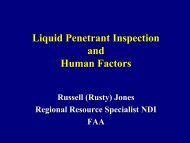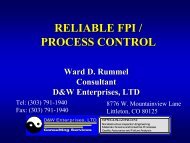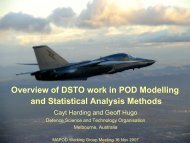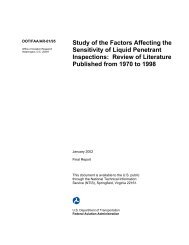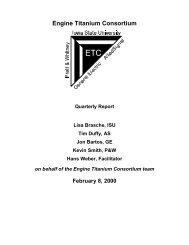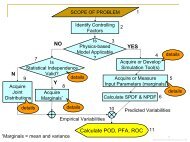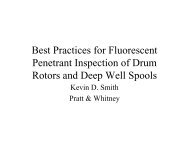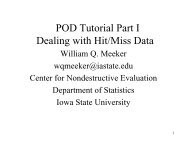Engine Titanium Consortium - Center for Nondestructive Evaluation ...
Engine Titanium Consortium - Center for Nondestructive Evaluation ...
Engine Titanium Consortium - Center for Nondestructive Evaluation ...
You also want an ePaper? Increase the reach of your titles
YUMPU automatically turns print PDFs into web optimized ePapers that Google loves.
possible candidates. Development work on these approaches will be limited to building one sensor<br />
assembly <strong>for</strong> each approach if suitable sensors are not already available at the OEMs. <strong>Evaluation</strong><br />
will be per<strong>for</strong>med on appropriate ETC test specimens with both flat and curved sound entry<br />
surfaces. It is expected that phased array approaches will be necessary to arrive at the necessary<br />
sensitivity through curved surfaces. Arrangements will be made to accommodate full team<br />
participation <strong>for</strong> all of these evaluations. The results will be reviewed to identify a preferred<br />
alternative inspection technology. The review will consider inspection per<strong>for</strong>mance, equipment cost<br />
and complexity, operating speed, potential <strong>for</strong> productivity improvements, and other implementation<br />
factors.<br />
Phased Array Laboratory Testbed: A laboratory testbed <strong>for</strong> the development and evaluation of the<br />
alternative inspection approach <strong>for</strong> a 1/128” FBH calibration <strong>for</strong>ging inspection with digital C-scan<br />
data acquisition and SNR based rejection criterion will be established. Additional transducers<br />
necessary to inspect the OEM <strong>for</strong>gings will be designed, manufactured and tested. Scan plans <strong>for</strong><br />
the selected OEM <strong>for</strong>gings will be developed. A limited number (1-2) of each of the selected<br />
<strong>for</strong>gings will be inspected per the scan plan. The full description of the testbed is not known at this<br />
time because of its dependence on the initial assessment. An amendment and appropriate request<br />
<strong>for</strong> funding will be prepared in consultation with the FAA when the details are completed.<br />
Factory Testbed, <strong>Evaluation</strong> and Demonstration: The laboratory results from the fixed-focus and<br />
alternative inspection method will be reviewed to identify a preferred configuration <strong>for</strong> factory<br />
demonstration and potential implementation. The review will consider inspection per<strong>for</strong>mance,<br />
equipment cost and complexity, operating speed, and other implementation factors. A hybrid<br />
system using fixed focus and an alternative inspection technology will be considered as part of this<br />
evaluation. The chosen configuration will be used to per<strong>for</strong>m factory evaluation of 30 <strong>for</strong>gings at a<br />
production inspection facility. A production testbed with digital C-scan data acquisition will be<br />
established <strong>for</strong> the evaluation of the 1/128” FBH calibration <strong>for</strong>ging inspection technique. (This may<br />
include the purchase of additional capital equipment if none is present at production inspection<br />
facility or available <strong>for</strong> loan from a consortium member.) Scan plans <strong>for</strong> the selected OEM <strong>for</strong>gings<br />
will be written by the respective OEM with ISU providing support using the inspectability model<br />
tools. Attention will be given to maximize productivity (to minimize any cycle time impact caused by<br />
the higher sensitivity) <strong>for</strong> the inspection during the production testbed design and scan plan<br />
development. Any additional transducers required to implement the scan plans will be designed<br />
using the transducer design models and built using commercial sources. A total of 30 <strong>for</strong>gings (10<br />
from each OEM) will be inspected over the course of 10 months. Noise levels with respect to the<br />
calibration target, and actual inspection time in hours will be documented <strong>for</strong> each <strong>for</strong>ging and<br />
provided to task 3.1.2. Any detections will be first reported to the responsible OEM. Up to six<br />
indications (from up to three separate <strong>for</strong>gings) which fail the proposed acceptance limits will be<br />
destructively evaluated to determine their cause. Funds to purchase these <strong>for</strong>gings are not<br />
included in the current proposal but will require an amendment at the time. The actual hours <strong>for</strong> the<br />
conventional production inspection of these <strong>for</strong>gings will be gathered and compared to the time of<br />
the 1/128” FBH inspection to establish a per part cost difference. Additional cost components will<br />
include items such as system cost, longevity of equipment, recurring equipment costs, and costs<br />
associated with false calls. An industry demonstration will be held to provide the results to the other<br />
Quarterly Report – January 1, 2002 –March 31, 2002<br />
print date/time: 6/6/2002 - 8:39 AM – Page 56



